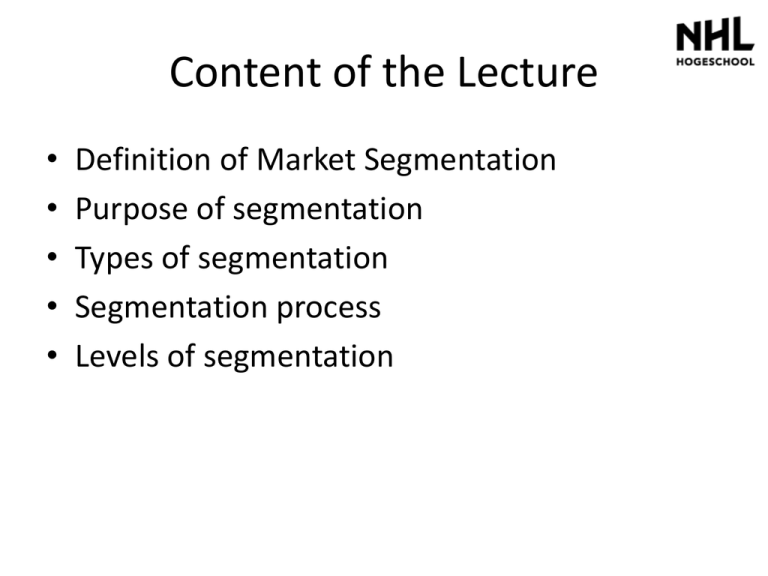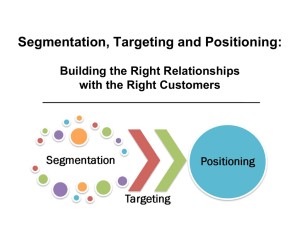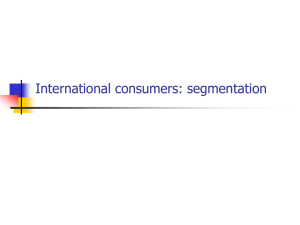segmentation
advertisement

Content of the Lecture • • • • • Definition of Market Segmentation Purpose of segmentation Types of segmentation Segmentation process Levels of segmentation What really is a market? A place where forces of demand and supply operate Essentials of Segmentation / Targeting • What is the size of the market? • What unique need does your GENRE of product/ services meet? • How much are customers willing to pay for this product/ service (top/ bottom/average)? • Is this a price sensitive/ commodity product or premium product? • Who are the other key players? • What is the gap un-serviced by current players? • What is the REAL available market for you? • How is your product different from competition? • What is your playing field? (premium/ general/ price warrior) • What share of this can you reasonably expect to get? Definition • A market segment is a subgroup of people or organizations sharing one or more characteristics that cause them to have similar product needs. it is distinct from other segments (heterogeneity across segments) it is homogeneous within the segment (exhibits common attributes) it responds similarly to a market stimuli it can be reached by a Communication Channel Criteria for Segmentation Measurable Accessible • Size, purchasing power, profiles of segments can be measured • Can be reached and served Substantial • Large and profitable enough to serve Differential • Respond differently Actionable • Effective programs can be developed Purpose • Increase marketing efficiency by focusing marketing efforts to a particular group • Maximize scarce marketing resources • Find a market with limited competition • Select the most profitable segment Product Segementation by Industry Segmentation Criteria • Geographic variables – region of the world or country: East, West, South, North, Central, coastal, hilly, etc. – size: Metropolitan Cities, small cities, towns. – density of area: Urban, Semi-urban, Rural. – climate: Hot, Cold, Humid, Rainy. Segmentation Criteria Geographic Nations, states, regions or cities Demographic Age, gender, family size and life cycle, or income Psychographic Social class, lifestyle, or personality Behavioral Occasions, benefits, uses, or responses Demographic Criteria • Demographic variables – age – gender – sexual orientation – family size – family life cycle – education – income – occupation – socioeconomic status – religion – nationality/race – language Psychographic Criteria • Psychographic variables – – – – personality life style value attitude Behavioral Criteria • Behavioral variables – – – – – – – – – benefit sought product usage rate brand loyalty product end use readiness-to-buy stage decision making unit profitability income status Heavy Users / Light Users Segmenting Business Markets • Demographic segmentation – Industry, company size, location • Operating variables – Technology, usage status, customer capabilities • Purchasing approaches • Situational factors – Urgency, specific application, size of order • Personal characteristics – Buyer-seller similarity, attitudes toward risk, loyalty Segmenting International Markets • Geographic segmentation – Location or region • Economic factors – Population income or level of economic development – Emerging Countries • Political and legal factors – Type / stability of government, monetary regulations, bureaucracy, etc. • Cultural factors – Language, religion, values, attitudes, customs, behavioral patterns Market Segmentation Process 1. Determine the characteristics of segments in the target market & separate these segments in the market based on these characteristics. 2. Verify the market segments size if adequate enough to support the organization's product. 3. Develop a marketing strategy to target this market. Market Segmentation Process Example minor Entrepreneurship Desktop Computers: - Home Use - Office Use - Gaming Market Segmentation Process 6. Develop Marketing Mix for Each Target Segment 5. Develop Positioning for Each Target Segment 4. Select Target Segment(s) 3. Develop Measures of Segment Attractiveness 2. Develop Profiles of Resulting Segments 1. Identify Bases for Segmenting the Market Market Positioning Market Targeting Market Segmentation Levels of Segmentation Mass Marketing Same product to all consumers (no segmentation) Segment Marketing Different products to one or more segments (some segmentation) Niche Marketing Different products to subgroups within segments ( more segmentation) Micromarketing Products to suit the tastes of individuals or locations (complete segmentation) Target Marketing Consists of a set of buyers who share common needs or characteristics that the company decides to serve Target Marketing • Evaluating Market Segments – Segment size and growth – Segment structural attractiveness • • • • Level of competition Substitute products Power of buyers Powerful suppliers – Company objectives and resources Target Marketing • Selecting Target Market Segments – – – – Undifferentiated (mass) marketing Differentiated (segmented) marketing Concentrated (niche) marketing Micromarketing (local or individual) Company Company • • • • Shampoo Shampoo for dry hair, long hair etc Shampoo with natural ingredients Shampoo for Hair salons Company Choosing a Target Marketing Strategy • Considerations include: – Company resources – The degree of product variability – Product’s life-cycle stage – Market variability – Competitors’ marketing strategies – References, experience with the market Positioning – The term 'positioning' refers to the consumer's perception of a product or service in relation to its competitors. – Positioning is all about 'perception'. – Perception differs from person to person, market to market e.g what you perceive as quality, value for money, etc, is different to my perception Essentials of Segmentation / Targeting • What is the size of your market? • What unique need does your product/ services meet? • How much are customers willing to pay for your product/ service (top/ bottom/average)? • Is this a price sensitive/ commodity product or premium product? • Who are the other key players? • What is the gap un-serviced by current players? • What is the REAL available market for you? • How is your product different from competition? • What is your playing field? (premium/ general/ price warrior) • What share of this can you reasonably expect to get?










